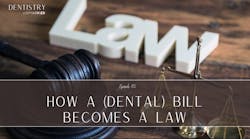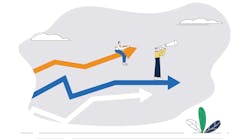What's changed in dentistry since 2020? 12 dentists weigh in
The COVID-19 pandemic didn’t just disrupt dental practices temporarily—it triggered lasting changes across the entire dental industry. From shifting patient spending habits and rising overhead costs to accelerated adoption of artificial intelligence and growing workforce challenges, dentistry today looks very different than it did in early 2020.
In this article, members of the Dental Economics Advisory Board reflect on 12 key ways the pandemic has reshaped the profession—from business models and clinical workflows to team dynamics and patient care.
Disposable income for dentistry has declined
Joshua Austin, DDS, MAGD
In the second half of 2020, I feel like more patients had more disposable income than they have today. Because people had stimulus money, nowhere to travel to for vacation, and less things to spend disposable income on, we did more high value cases.
It seems like today, people are more reserved about spending money on things like esthetics, Invisalign, implants, etc. It’s not that we aren’t doing those cases, we are just doing less than we did in 2020. People seem more concerned about the economy. Unease and unrest around potential changes in governmental programs has many people shaken. Inflation continues to be a problem for many Americans, which has been changing their spending habits.
The pandemic accelerated our adoption of AI
Amrita R. Patel, DDS, FICD, FPFA
Since 2020, the dental industry has experienced rapid changes driven by the pandemic’s lasting effects. One of the most transformative shifts has been the adoption of artificial intelligence (AI). Dental practices now leverage AI for diagnostics, where advanced algorithms assist in detecting caries, periodontal disease, and other oral conditions with improved accuracy. Additionally, AI-powered practice management systems enhance operational efficiency by optimizing patient scheduling, managing inventory, and reducing administrative burdens.
Workforce shortages remain a critical challenge. The pandemic accelerated the retirement of many experienced dental professionals, creating gaps in both clinical and administrative roles. Dental hygienists and assistants are particularly in short supply, leading to increased workloads and higher burnout rates among existing staff. This shortage has also affected new dental graduates, who are entering a demanding environment where they must quickly adapt to digital workflows and patient expectations.
New graduates face both opportunities and challenges. While there is high demand for their skills, they must navigate a rapidly evolving field that increasingly relies on AI and advanced technologies. Practices investing in innovation and fostering supportive work environments are better equipped to attract and retain new talent.
Everyone revisited their values and strategies, and the effects are tangible
David R. Rice, DDS
“There is nothing permanent except change.”—Heraclitus
The dental ecosystem has changed immensely since 2020. Although the players have remained constant, the perceptions and values of many have morphed. Hygienists and assistants have questioned their “why.” They’ve contemplated their roles; and they’ve redefined the workforce as we knew it.
Dentists have discovered new ways to compensate, and some have rediscovered the “hygieneless” practice model. Once appointment-accountable patients have reestablished that their schedules and lives come first.
The beauty in it all is a second quote… “When you change the way you look at things, the things you look at change.”—Wayne Dyer
When we recognize that change will continue to happen and that we have the power to not simply tread water, but master the seas, all change really means is we have another opportunity to innovate and thrive.
Mental health is down, polypharmacy is up
Scott Froum, DDS
I would say the biggest change I have noticed since the pandemic is the increased amount of medication that patients are taking. Even the younger ones seem to be on more antianxiety medications and or chronic inflammatory medications. This aligns with a recent study in Gallup that showed that more Americans rate both their mental health and overall physical health 31% more poor since COVID. Taking a proper medical history more important than ever.
Oral hygiene has noticeably improved
Howard Glazer, DDS, FAGD
It is hard to believe that we are now 5 years after the nightmare of the COVID-19 pandemic. I think that dental practice has remained the same with a few small caveats. I think there is a new awareness and adherence to infection control protocols, and I am seeing better oral hygiene. Perhaps the message of “healthy mouth, healthy body” has taken hold in the minds of our patients who are more cognizant of how deadly infections can spread.
I would hope that many of the additional protective measures undertaken during the pandemic continue to be implemented and that is for the betterment of our staff, ourselves and our patients. I know in several instances some colleagues choose to retire earlier than anticipated, while other fellow practitioners used the downtime to remodel, re-invest and renew their facilities. On the downside, I think the post-pandemic years have seen a decline in the dental workforce in all categories: dentist, hygienist, assistants, and front office personnel.
Private practice ownership has been completely reshaped
Alan Mead, DDS
The COVID-19 pandemic significantly altered the realities of dental practice ownership. Operational expenses soared, with labor costs rising by 20% or more. While supply chain issues have largely resolved, the inflated prices of materials remain a persistent challenge. Simultaneously, dental insurance reimbursements have remained stagnant or, in some cases, decreased, creating a significant financial strain.
Beyond the financial impact, the pandemic has taken a toll on professional morale. The experience of operating under the state's regulatory authority, with the potential for future shutdowns, has introduced a sense of uncertainty. While the immediate threat of closure has subsided, the memory has left a lasting impression.
These factors have collectively reshaped the experience of owning a private dental practice. The perception of a reliably prosperous profession has shifted, requiring dentists to navigate a more complex and challenging economic landscape.
Team accountability has declined while staffing costs have increased
Tarun Agarwal, DDS
Dentistry hasn’t changed terribly much.
We have seen greater emphasis on technology adoption and integration. The main area I have seen dramatic change is team overhead and our ability to hold team accountability. The workforce has clearly made a shift.
Dentistry has emerged stronger
Chad C. Duplantis, DDS, FAGD
It may feel like a lifetime ago, but in March of 2020, many of us experienced a moment that will never be forgotten—the day when “our world came to an end.” It was unprecedented. None of us could have imagined that the world would come to a complete halt, yet it did. The impact was sudden and overwhelming. Our practices and personal finances were thrown into uncertainty, leaving many of us questioning how we would ever recover. Thankfully, the government stepped in to provide support, and while it wasn’t perfect, it was enough to help sustain most dental practices.
Looking back, I don’t think any of us could have predicted how we would emerge from this crisis. Would we be stronger or weaker than before? Sadly, some practices didn’t survive, and some clinicians chose to retire. Yet, in the grand scheme of things, dentistry fared far better than many other industries.
Now, as we reflect on how we’ve come through this challenging time, it’s clear that dentistry has, by and large, emerged stronger. Yes, costs are higher and labor is more expensive, but we’ve proven ourselves to be a resilient profession, and our services remain in demand. In our own practice, we’ve seen significant growth over the past three years in both production and new patient influx. The numbers have been remarkable.
While the immediate threat of a shutdown may be behind us, the memory of that uncertainty still lingers. Hopefully, we are now better equipped and more prepared in the event of any future challenges.
With reimbursement and staff costs, we’re feeling the crunch financially
Erin Elliott, DDS, DASBA
I used to say that 96% of our patients were awesome, grateful and considerate. Ever since COVID that number is 92%. Patients' fuses seem to be shorter and no shows have increased.
Immediately after COVID, we did have many patients follow through with large treatment plans they have been putting off. I believe it was because we were not competing with vacations and "toys."
With supply costs soaring and insurance reimbursements not keeping pace or increased at all, there has been a crunch we hadn't felt before. Not only that, but we also had to increase employee wages significantly. The power belonged to the employees immediately after COVID, and staff was hard to find. We have always had long-term employees, but there was a lot of changeover the last few years as employees left the industry or left for more money. It was even hard to find an applicant to show up to an interview! That always shocks me.
Lastly, due to the increase of overhead we decided to drop our in-network status with all insurances except for two. I've noticed that many dentists are going fee-for-service since COVID.
Things seem to be settling down but due to the pandemic, technological advances, and a shift in the employee and patient population dentistry will never be the same.
A more demanding business environment means I’ve had to become more savvy
Stacey L. Gividen, DDS
Overall, the flow of postpandemic dentistry is steady, but I've found that insurance is more of a pain than anything: smaller reimbursements, having to prove everything that I do is "real." Employees are also harder to find, especially hygienists. It's hard to justify their hourly wage when insurance contracts make their time with the patients almost zero out financially.
I've also seen overhead increases with little return to back it up on the front end, making profitability less. One company I looked into to help sever the contract tie I have with two insurances wanted to charge me $42,000! That's like charging $10,000 for a crown just because someone is "rich."
Where has all the business and company integrity gone? I'd say I've had to become more of a savvy business owner in a more demanding arena, especially since the embezzlement that I experienced. I think the staff is understanding of all the above but sometimes it's hard to put on a front of optimism when there are so many things that commandeer what limited time is available.
Regardless, I'm still L-I-V-I-N and making the most of it. I tell people dentistry is what I do, not who I am. It's a stoic approach that has and continues to serve me well.
The financial squeeze on the industry is creating a tense future
Jennifer Bell, DDS
In the post-COVID world, one might expect that the most obvious change for dentists would be heightened infection control protocols. After all, medical offices have certainly ramped up their efforts in this area.
However, for many dental practices, it’s been more of the same. Even before the pandemic, dentists were already implementing rigorous measures for aerosol management and infection control, so there’s been minimal change in that regard. What’s far more striking is the drastic impact COVID has had on the practice of dentistry and the financial stability of dental offices.
Since 2020, doctors are facing pay cuts, while staff and support personnel are seeing significant salary increases. Meanwhile, borrowing costs are soaring, and operational expenses continue to climb, all while insurance reimbursements and patient payments shrink. This financial squeeze on the industry is creating a tense future for both dentists and their patients, with the long-term effects on practice types and clinician morale still unclear.
Exchange of knowledge via CE is thriving
Neville T. Hatfield, DMD
As a young dentist in the early years of my career, most of my professional experience has taken place in the COVID-19 and post-COVID-19 era. While I lack personal experience with the pre-2020 landscape for direct comparison, my perspective has highlighted two significant shifts in dental education and collaboration.
-
The transition from in-person learning to predominantly online formats.
-
A broader, more immediate exchange of case discussions and problem-solving, facilitated by social media and online forums.
In the New Jersey/New York area, many study clubs and dental groups have struggled to regain participation, with some ceasing to sponsor continuing education (CE) events or becoming inactive altogether. In response, many young dentists, myself included, have turned to social media platforms like Facebook and Instagram for CE opportunities and case discussions. CE courses now frequently incorporate online video sessions, reserving in-person meetings for condensed, hands-on training.
From my experience, case discussions primarily occur on social media rather than traditional forums or in-person meetings. This shift has enhanced accessibility and anonymity, allowing more dentists to seek guidance with greater confidence in their daily practice. Additionally, it has created a space for dentists with more introverted dispositions to participate in discussions and learning opportunities without the pressure of in-person interactions, fostering a more inclusive and diverse exchange of knowledge.
Read more at RDH: Here's how dental hygienists are saying the pandemic changed things for them.
What else is changing in dentistry?
About the Author
Amelia Williamson DeStefano, MA
Group Editorial Director
Amelia Williamson DeStefano, MA, is group editorial director of the Endeavor Business Media Dental Group, where she leads the publication of high-quality content that empowers oral-health professionals to advance patient well-being, succeed in business, and cultivate professional joy and fulfillment. She holds a master's in English Literature from the University of Tulsa and has worked in dental media since 2015.





